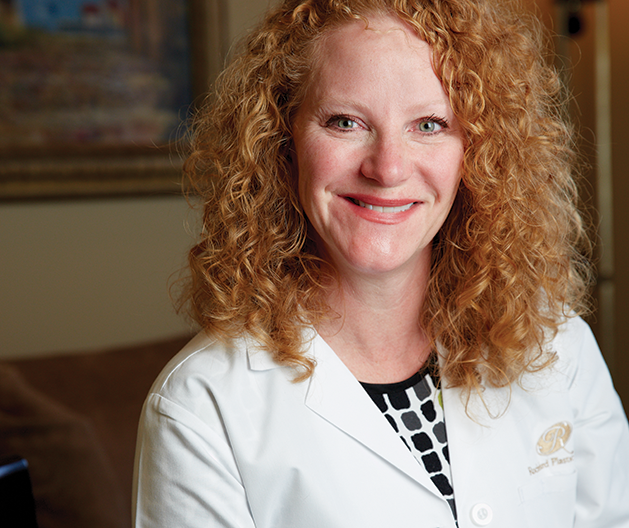
Although it was once thought to be exclusively for the rich and famous, plastic surgery has become mainstream in recent years, and it’s only getting more popular. An increasing number of people are now opting to go under the knife, especially because new innovations have made such procedures more accessible and affordable than ever. If you’ve been considering plastic surgery, there’s no time like the present.
The term “plastic surgery” encompasses many different things: there are breast augmentations, tummy tucks and nose jobs, but there are plenty of smaller, less invasive procedures as well. And it isn’t just about looks either. Although it’s often relied on for improved physical appearance, plastic surgery can likewise improve overall health and quality of life.
Dr. Garrett Griffin is a plastic surgeon at Midwest Facial Plastic Surgery and Aesthetic Skincare, which has served the Woodbury community for 20 years. He says that cosmetic surgeries only make up a portion of his total procedures, while reconstructive surgeries are about half. Most of his reconstructive surgeries are facial-related, particularly post skin cancer removal or trauma. “I firmly believe that [these] two types of surgery are complementary,” Griffin says. “All cosmetic surgeries must include a reconstructive component to ensure that the results are natural and long-lasting. Likewise, the goal of any facial reconstructive surgery is to fully restore the patient’s appearance and beauty.”
Griffin says that he also has a particular interest in treating patients with Bell’s palsy and facial paralysis. “This can be a devastating condition that affects not only a person’s appearance, but self-esteem and social functioning as well. Many of these patients cannot accurately express their emotions.” Many primary care doctors are at a loss when it comes to where to refer such patients, but Griffin says that with the right doctor, a cure is possible. “Most of these patients can be helped using a combination of physical therapy, Botox to improve facial control and/or surgery to help restore movement,” he says.
Plastic surgery is available as a treatment for a wide range of things—it all depends on what a patient is looking for. Griffin says that individual motivations are the most important consideration. “The goal of plastic surgery is not to completely change the way a person looks. It will not completely change their life or personality or dating prospects or work success,” he says. “If a person thinks, ‘I want plastic surgery to be a little more confident and to be the best version of myself,’ then that person is ready to consider plastic surgery.”
Once the right motivations have been established, it’s important to find the right doctor. Dr. Heather Rocheford of Rocheford Plastic Surgery in Woodbury says that a board-certified surgeon with a good reputation is a must. “It’s always good to get a referral or read reviews so that you really do your research prior to deciding on a surgeon,” she says. “I don’t think that any surgeon would be unhappy, and certainly I wouldn’t be [if a patient wanted to wait and research]. I think it’s better to hear three people say good things than to just go with the first person and say, ‘OK, well I haven’t done any research, but I’m going to do it anyway.’”
Rocheford has run her own practice since 2003 but has been a plastic surgeon since the 1990s. She says that the field has changed dramatically since she first started. “As more and more patients want less invasive treatments that they have less downtime for, there’s been quite a few advancements in laser treatments, especially in body contouring,” she says.
One example is the Body FX Fat Removal Laser, which helps even out fat irregularities and tighten the skin through radio frequency. “It especially works very well in smaller areas, like underneath the chin,” Rocheford says. “It’s also great for the bra roll and the back of the arms.”
Other treatments with little downtime include injectables, which can be both an alternative and a complement to surgery. Rocheford says that these have skyrocketed in popularity in recent years, especially because recovery time is minimal. Fillers are typically used on the nasolabial folds (“laugh lines”), which go from either side of the nose to the mouth, along with the marionette lines, which run from the corners of the mouth down to the chin.
“Everybody eventually gets those sort of smoker’s lines, because everybody moves their mouth,” Rocheford says. “When you’re younger, of course, your collagen is better. It bounces back, and you don’t get those lines. But, as we age, we lose collagen, and those lines start to show—not just in smokers but people who have sun exposure, genetics, and then environmental exposure. Fillers work very nicely in those lip lines as well as in the lip volume.”
One downside of fillers is the fact that they aren’t permanent and have to be redone every so often, but thanks to new advancements, longer-lasting fillers are now the norm. “Three months was pretty much the maximum for collagen injections when I first started practice, and then the hyaluronic acid fillers came out. Those are mainly Restalyne and Juvederm, and they’ve progressed to longer-lasting fillers,” Rocheford says. Now, there are fillers that last three to five years.
Both Griffin and Rocheford emphasize that there is no one-size-fits-all approach to plastic surgery or aesthetic services. “Just like not all haircuts are the same—it depends on the stylist—not all injectables are the same,” Griffin says. “It is important not just who does your facelift but who does your Botox and filler as well.”
And transformative plastic surgery is most effective when it goes hand-in-hand with a commitment to health. “If you’re concerned about your facial aging appearance, things you can do to control it would be to limit sun exposure and wear sunscreen,” Rocheford says. “When it comes to body contouring, obviously be an ideal weight or at least a stable weight.” She also tells her patients to stop smoking—ideally forever, but at least four weeks before surgery. “The biggest thing is to come into it healthy and to have people help you afterwards,” she says.









